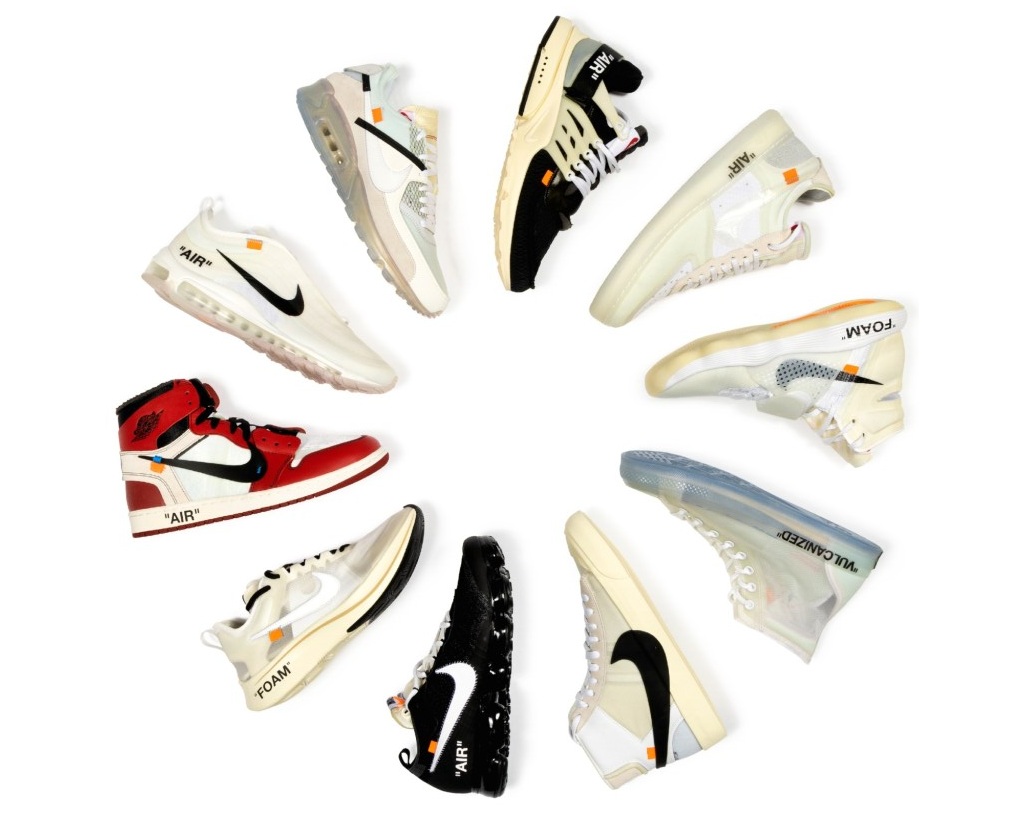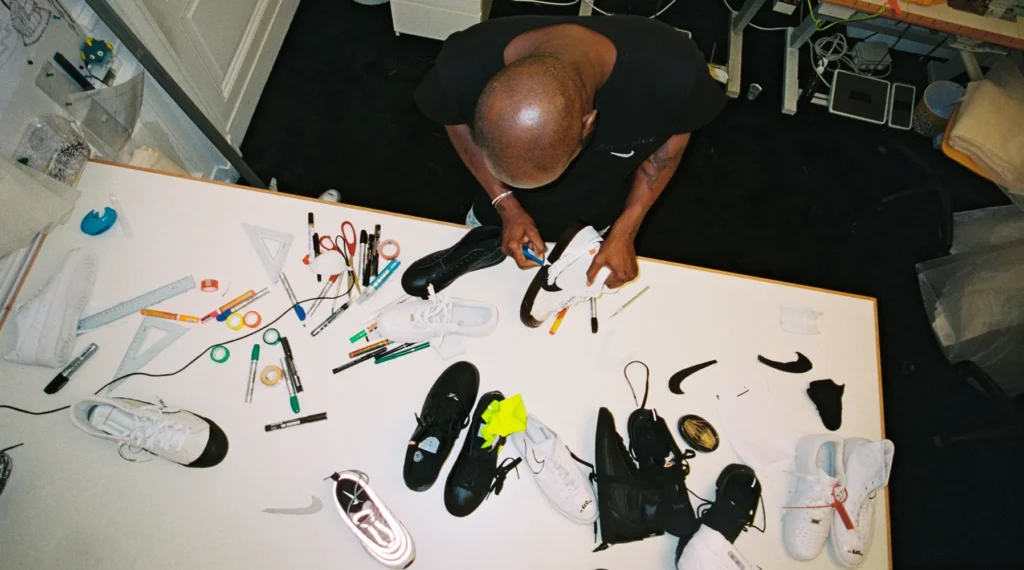Picture this: you’re walking down a busy street, maybe in New York, Los Angeles or Tokyo, and suddenly your eyes catch something different. A pair of sneakers shines on someone’s feet: an Air Jordan 1 with an orange zip tie hanging, exposed stitches, and a quote that seems to mock the very simplicity of the shoe. Or maybe it’s an Air Force 1 with a neon sole that looks like it came out of a secret design lab. This isn’t just a sneaker, my friend. It’s the collaboration between Nike and Off-White, a partnership that took the world of sneakers, fashion, and pop culture by storm and still hasn’t let go of the reins.
But how did this story begin? Who was the mastermind behind this revolution? And why, years later, are we still obsessed with these sneakers? In this article, we’ll dive headfirst into this epic collaboration. We’ll explore everything from Virgil Abloh’s first sketches to the posthumous releases that continue to surprise us. Get ready for a long journey, full of curiosities, juicy details, and a laid-back look at how this union turned sneakers into art and, in the process, changed the fashion game forever. Grab a coffee, tighten your laces, and let’s go!
The Origin: How Nike and Off-White Came Together
It all started in 2016, but to truly understand, we need to go back a little further. Virgil Abloh, the guy who would later be the mastermind behind this collaboration, grew up in Rockford, Illinois, in the 80s and 90s. The son of Ghanaian immigrants, he was a typical teenager, passionate about skateboarding, hip-hop, and, of course, sneakers. He and his friends spent hours drawing imaginary versions of Air Jordans and Air Maxes, sending sketches to Nike in hopes of one day being noticed. Spoiler: Nike didn’t respond at the time, but the universe had other plans.
Fast forward to 2016. Virgil was no longer that dreamy kid. He had founded Off-White in 2012, a brand that mixed streetwear with high fashion in a way no one had seen before. He had already worked with Kanye West, become a hot name in the fashion scene, and started catching the attention of giants like Nike. It was that year that he stepped into the brand’s headquarters in Beaverton, Oregon, with a bold proposal: to reimagine some of the most iconic sneakers in history.
Nike, known for its sports legacy, saw in Virgil a chance to connect with a new generation. It wasn’t just about selling sneakers: it was about creating something that transcended sports and entered the realm of art and culture. Thus was born “The Ten” project, launched in 2017, which would be the starting point of one of the most influential collaborations of the decade. In an interview with Nike News, Virgil described the moment as “a dream come true,” but with a clear mission: to deconstruct the past to build the future.
What made this origin so special was the contrast. On one side, Nike, a giant with over 50 years of history, rooted in sports and performance. On the other, Off-White, a young, rebellious brand that challenged the rules of traditional fashion. Together, they created something no one expected and that changed everything.
The Ten: The Project That Launched the Revolution

“The Ten” was not just a collection of sneakers: it was a manifesto. Launched in 2017, it brought ten classic Nike silhouettes, divided into two parts: “Revealing” and “Ghosting.” Let’s break it down, because each of these phases deserves a deep dive.
The first batch, “Revealing,” was about exposing what is normally hidden. Virgil took models like the Air Jordan 1, the Air Presto, the Air Max 90, the Blazer Mid, and the Nike Air VaporMax and opened them up like a surgeon. He cut pieces of the upper, left the inner foam exposed, added rough stitches, and glued that zip tie tag that would become a trademark. The Air Jordan 1 “Chicago,” for example, kept the classic red, white, and black colors but with a hand-stitched swoosh and the word “AIR” written in large letters on the side. It was as if he was saying, “Look, I know what this sneaker means, but I’m going to show you something new.”
The second part, “Ghosting,” took deconstruction even further. Here came the Converse Chuck Taylor (part of the Nike group), the Nike Zoom Fly, the Air Force 1 Low, the React Hyperdunk, and the Air Max 97, all with translucent uppers. These sneakers looked like ghostly versions of the originals, with materials that revealed the interior and a futuristic vibe. The Air Max 97, with its shiny silver and neon details, was almost a spaceship on your feet.
The creative process was insane. According to Nike, Virgil and his team finalized “The Ten” in less than ten months: a ridiculously short timeframe for something so detailed. He worked with Nike engineers to ensure the sneakers were still wearable, but the focus was on aesthetics. At a launch event in New York, reported by Vogue, Virgil said he wanted each pair to be “an accessible piece of industrial design for everyone.” And so it was: the sneakers sold out in minutes, and the resale market became a battleground.
A curious detail? The Air Jordan 1 “Chicago” from the collection was originally sold for $190, but today you can find pairs on StockX for over $3,000. “The Ten” didn’t just launch the collaboration: it launched a movement.
Virgil Abloh: The Architect Who Became a Fashion Legend

To understand the heart of this collaboration, we need to know Virgil Abloh. He wasn’t a typical designer: in fact, he didn’t have traditional fashion training. Born in 1980, Virgil studied civil engineering at the University of Wisconsin-Madison and later architecture at the Illinois Institute of Technology. But his love for street culture, music, and design led him down a different path.
In the 2000s, he began working with Kanye West, helping to create album covers like *My Beautiful Dark Twisted Fantasy* and the DONDA brand. In 2012, he founded Off-White, which he described as “the gray space between black and white”: a metaphor for his vision of blending streetwear with luxury. When Nike came knocking on his door, Virgil was already an established name but still carried that spirit of a teenager who doodled sneakers in notebooks.
Virgil brought a unique philosophy to the collaboration: the “3% rule.” He believed that changing just 3% of an object could completely transform it. This is reflected in every Nike x Off-White sneaker: small adjustments, like a repositioned swoosh or ironic text, created something new without erasing the original. In an interview with GQ, he said, “I want people to see the process, not just the final product.” And that’s exactly what he delivered.
His death in November 2021, at the age of 41, from a rare cardiac angiosarcoma, shocked the world. But his impact remains. Virgil wasn’t just a designer: he was a symbol of inclusion, a Black man who rose to the top of a white-dominated world, and a creator who showed that fashion could be for everyone.
Design Details: What Defined the Nike x Off-White Style

If you’ve ever seen a Nike x Off-White sneaker in person, you know that the details are everything. Let’s break down the elements that made this collaboration so recognizable and desirable:
The zip tie tag: This little piece of colored plastic, usually orange but sometimes green or white, is the DNA of the collab. It has no practical function but has become a seal of authenticity. Virgil said it was a reference to industrial seals, a playful nod to the idea of an “unfinished product.”
Quoted text: Words like “AIR,” “SHOELACES,” or “FOAM” appear in large letters, often with ironic quotes. It was as if Virgil was laughing at the obvious, turning the functional into art. On the Air Presto, for example, “AIR” is stamped on the side like a visual scream.
Deconstruction: Exposed stitches, visible foam, hand-stitched swooshes: everything gave a raw, almost DIY look. The Air Jordan 1 “Off-White” looks like it was taken apart and reassembled by a street artist.
Bold materials: Virgil wasn’t afraid to experiment. The Air Force 1 “Volt” brought a neon yellow that almost blinded, while the Air Max 97 “Ghosting” used a translucent upper that seemed to float. He mixed the sporty with the futuristic in a unique way.
Color palette: From classic colors like the “Chicago” (red, white, and black) to neon explosions like the “Volt,” each release had its own identity. Even pastel tones, like on the Air Max 90 “Desert Ore,” showed his versatility.
These details weren’t just embellishments: they were a narrative. Each sneaker told the story of its creation, as if Virgil was inviting us to be part of the process. And the best part? Despite all this complexity, the designs were accessible, at least in theory, before resale prices skyrocketed.
Cultural Impact: Sneakers That Became Culture
The Nike x Off-White collaboration didn’t just stay on the feet of sneakerheads: it invaded pop culture as a whole. Before “The Ten,” streetwear was already on the rise, with brands like Supreme and Palace dominating the scene. But when Virgil entered the scene with Nike, he took the game to another level.
The releases became events. In 2017, the drop of “The Ten” in cities like New York, London, and Milan attracted mile-long lines. YouTube videos and Instagram posts exploded with unboxings and reviews. According to an analysis by UOL, the collab generated over 2.6 million Google searches and 72 million views on TikTok by 2022. This isn’t just hype: it’s a phenomenon.
But the impact goes beyond the numbers. Virgil, as one of the first Black men to lead a luxury brand (he was also the creative director of Louis Vuitton menswear), opened doors for diversity in fashion. He brought streetwear to high fashion runways and showed that sneakers could be as valuable as a gala dress. The collaboration also inspired other brands, like Adidas with Kanye West or Puma with Rihanna, to bet on creative partnerships.
In the neighborhoods, the effect was visible. Teenagers who had never heard of high fashion began to dream of a pair of Off-Whites. Artists like Travis Scott and Drake wore the sneakers in music videos, while influencers on Instagram showed off their pairs like trophies. It was more than a shoe: it was a symbol of belonging to a global culture.
After Virgil: The Legacy Continues
When Virgil passed away in 2021, many feared the collaboration would end. After all, he was the creative heart behind it. But Nike and Off-White decided to honor his legacy with posthumous releases that keep the spirit alive.
One of the first was the Air Force 1 Mid, launched in 2022 to celebrate the model’s 40th anniversary. With details like spikes on the sole and a bright green upper, it brought the characteristic boldness of Virgil. Another highlight was the “Lot 50” collection of Nike Dunk Lows: 50 numbered variations, each with a unique touch, like leather overlays or textured soles. These designs were finalized by Virgil before his death, showing that he still had many ideas up his sleeve.
In 2023, we saw the Air Force 1 “Brooklyn,” an emerald green that paid homage to New York, and special editions like the revisited Air Max 97. These releases prove that the collaboration doesn’t depend solely on Virgil: it carries a DNA that can evolve over time. Nike has been working with the Off-White team to ensure that each pair still has that touch of genius that he brought.
What’s impressive is the consistency. Even without Virgil, the sneakers continue to sell out, resale prices remain high, and the hype doesn’t die. It’s a testament to the lasting impact of a man who saw sneakers as more than footwear: he saw them as culture.
Prices and Resale: The Market of Dreams (and Nightmares)

Now let’s talk numbers, because, yes, this collaboration is also a lesson in sneakerhead economics. When “The Ten” was released, the original prices ranged from $150 to $190 per pair. It seemed reasonable, right? Until the stocks sold out in seconds and the resale market kicked into action.
Today, an Air Jordan 1 “Chicago” from the original collection can cost over $3,000 on StockX. The Air Presto “Black” isn’t far behind, with prices around $1,500. Even newer models, like the Air Force 1 “Brooklyn,” range from $800 to $1,000. In Brazil, things get even crazier: on sites like Mercado Livre, used pairs can go for over R$5,000, and new ones easily reach R$10,000.
Why so expensive? First, the limited supply. Nike and Off-White have always released small quantities, creating an artificial scarcity that fuels desire. Second, the Virgil factor: after his death, the sneakers gained emotional and historical value. Third, sneakerhead culture: for many, these pairs are investments, like stocks or works of art.
But not everything is rosy. The resale market has also brought counterfeits. Almost perfect replicas circulate out there, fooling even the most attentive. That’s why platforms like StockX and GOAT have become references, offering professional authentication, but even so, the price of authenticity is high.
Conclusion: A Legacy That Shoes the World
We’ve reached the end of this journey, and one thing is clear: the Nike x Off-White collaboration is more than a sneaker story. It’s a story of creativity, boldness, and connection. Virgil Abloh took Nike’s sports legacy and transformed it into something that speaks to all of us, from street skaters to Parisian fashionistas. He showed us that a pair of sneakers can be art, can tell a story, can change the way we see the world.
We, as lovers of culture and sneakers, can only applaud. Each orange zip tie, each deconstructed swoosh, is proof that design can be revolutionary without losing its soul. And the best part? Even without Virgil, the partnership continues to surprise us, challenging us to imagine what comes next. So, the next time you come across a Nike x Off-White, don’t just see a shoe: see a piece of history that continues to walk, run, and fly.
FAQ
What is the Nike x Off-White collaboration?
It’s a partnership between Nike and Off-White, Virgil Abloh’s brand, which began in 2017 with “The Ten.” The idea was to deconstruct classic Nike sneakers and turn them into streetwear and high fashion pieces.
Who is Virgil Abloh?
Virgil Abloh was the founder of Off-White and the creative director of Louis Vuitton menswear. Trained as an architect, he revolutionized fashion with his unique vision and passed away in 2021, leaving a massive legacy.
Why is “The Ten” so famous?
“The Ten” reimagined ten Nike icons with deconstruction and details like zip ties and quoted text. It was the start of the collab and became a milestone among collectors and fashion fans.
Which sneakers are part of the collaboration?
In addition to the ten from “The Ten” (Air Jordan 1, Air Max 90, etc.), the collab includes the Air Force 1, Dunk Low, Air Max 97, and others, in various colors and limited editions.
Why are these sneakers so expensive?
Limited releases, Virgil’s name, and cultural hype drive resale prices through the roof. A pair that originally cost $190 can be worth thousands today.
Where can I buy a Nike x Off-White?
On the Nike website or at partner stores during official releases. For older editions, StockX, GOAT, or trusted marketplaces are options, but beware of fakes!
What does the zip tie mean?
The colored zip tie is an Off-White signature, with no practical function. It’s an aesthetic symbol that marks the authenticity of the collab’s sneakers.
Are there still new releases?
Yes! After Virgil’s death, Nike has released posthumous models, like the Air Force 1 Mid and the Dunks “Lot 50,” keeping his legacy alive.
How can I tell if a Nike x Off-White is fake?
Check the zip tie, typography, and stitching quality. Buying from authenticated platforms like StockX and GOAT helps avoid replicas.
What is the best model in the collaboration?
It depends on your taste! The Air Jordan 1 “Chicago” is the most iconic, but the Air Force 1 “Volt” and the Presto have loyal fans. Which one would you choose?
 Travis Scott x Fragment x Air Jordan 1 Low OG 2025
Travis Scott x Fragment x Air Jordan 1 Low OG 2025 Nike Air Force One: The Iconic Sneaker’s History & Impact
Nike Air Force One: The Iconic Sneaker’s History & Impact Air Jordan 1 – The Story of the Sneaker that Defied the Rules and Became Legend
Air Jordan 1 – The Story of the Sneaker that Defied the Rules and Became Legend What is Nike Air? Learn more about one of Nike’s Best Technologies
What is Nike Air? Learn more about one of Nike’s Best Technologies Top 10 Futuristic Nike Sneakers: Innovative Design and Cutting-Edge Technology
Top 10 Futuristic Nike Sneakers: Innovative Design and Cutting-Edge Technology The Journey of the Nike Dunk: A Timeless Story of Courts, Streets, and Culture
The Journey of the Nike Dunk: A Timeless Story of Courts, Streets, and Culture